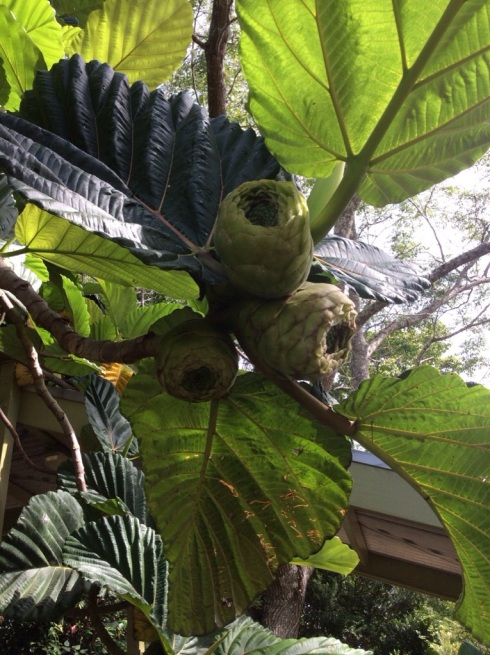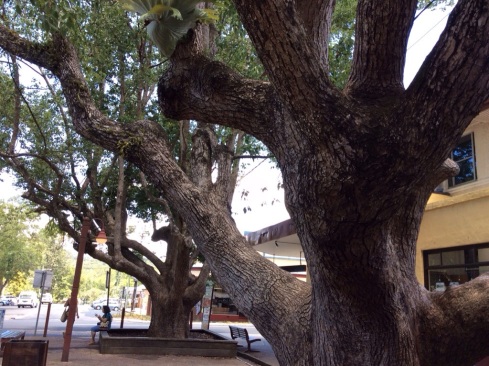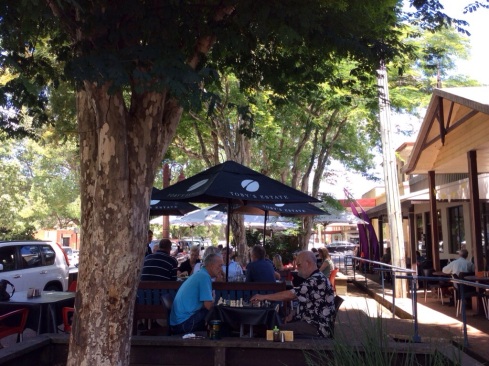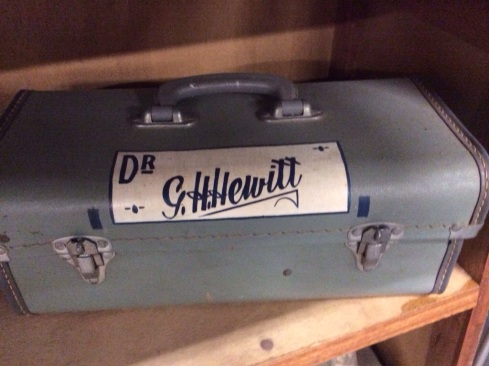These two trees look alien and out of place. The bright green intricately veined leaves would make respectable covers for small round cafe tables. The fruits are green globes with interwoven, ever receding hearts. Hunter, one of the maintenance staff at Bellingen Primary School, identifies them as Ficus damaropsis, native to Papua New Guinea, two of only four specimens of this plant in Australia. They are spectacular, gorgeous trees. The School Principal, Graeme Ross, says they’re a nuisance. Those big leaves blocked the eaves in the spring rains, damaging the ceiling of a whole classroom block. He’d sometimes like to chop them down, he says, but then a beatific expression crosses his face as he recalls “but they were planted by Dr Hewitt”.
What can cause a level-headed School Principal to overlook a threat to his school buildings? Who is this Dr Hewitt?
It turns out that Dr Hewitt was the Johnny Appleseed of the Bellinger River Valley.
When he first arrived in 1927 as a young GP the area had been denuded of trees by years of intense logging. The rolling hills and green meadows were open and bare. As well as his doctor’s bag (on display in the local Museum), George Hewitt brought with him a love of plants, and in 1929 he established the Bellinger River Horticultural and Agricultural Society and began planting trees.
At first, the town that earned its living from forestry resisted George Hewitt’s efforts. You didn’t plant trees, you chopped them down and sold them. But Dr Hewitt got around the objections of the locals with commemorative tree plantings to honour those who had gone to war. Once started, they couldn’t stop him, and now, many years later, the townscape of Bellingen, and the valley that it nestles in, are defined by the generous shade, colour and textural integrity of the trees. They say there’s something in the air of Bellingen that makes it a magical place, perhaps its the oxygen from all those trees. Bellingen is still a place where it is groovy to be a tree-hugger.
The Hospital was Dr Hewitt’s workplace, and he beautified it and planted out the adjoining Arboretum as a special place, a locus amoenus where he and his patients and colleagues could take a soothing, restorative walk. In the local Museum, these trees are listed with their provenance. There is tamarind, sassafras, South Queensland kauri, hoop pine, lilly pilly, tallowwood, leopard tree, floss silk tree, brown silky oak, black bean and pecan, amongst hundreds of others.
As well as planting an abundance of native trees, Dr Hewitt corresponded with other horticulturalists and imported seed from all over the world. Rumour has it that some of the seeds were concealed securely beneath postage stamps. Dr Hewitt was the ‘go to’ man for exotic trees, and property owners eagerly sought him out. Museum Manager Jim Sweeney says “nobody knows exactly how many trees Dr Hewitt planted, or where he planted them.” Council set up a study a few years ago, but had to abandon it when they realised the huge scope of the project. Dr Hewitt had a motto of planting “100 trees a year”. Multiply that by just under sixty years, and you can see why it would be a challenge to find every one of those trees.
Every street in the older parts of Bellingen town is richer and greener because of Dr Hewitt. Oak Street is lined with Firewheel trees, William Street has jacarandas. At the heart of the town is the river, and the river end of Church Street is a hub; crusted with cafes and restaurants, lined with generous public seating. As I sip coffee and nibble on wildberry damper, the manager of the Bellingen Markets sits opposite, gnawing her pen as she works on a newsletter. A bunch of people are playing chess nearby. There are couples and singles, families eat pies, teenagers saunter with ice cream, bohemian women pause from their shopping. All of us are beneath the protective boughs of Dr Hewitt’s trees. His living legacy is a shade thrown from the past over us here and now.





Leave a comment